The Only Software Testing Checklist You Need
From jotting down groceries to planning our daily activities, checklists help us stay organized and focused. And not to mention that feeling of accomplishment when you cross off your tasks one by one. In the practical world of IT, especially in Quality Assurance (QA), checklists are more than just handy. Whether ticking off completed tasks like filling timesheets, finishing documentation, or attending scheduled meetings, checklists bring a sense of order and achievement to our workday.
How do we use this helpful tool in QA? So, let's see practical examples of how checklists can make your software testing work better organized and more efficient.
Understanding testing checklists
A software testing checklist serves as a guide to testers. Its goal is to ensure comprehensive coverage during software testing in a clear and systematic way, using tasks or items.
Unlike detailed test cases, checklists offer a broader overview. They typically don't include granular, step-by-step instructions but instead focus on key areas or features that require testing. Checklists are invaluable for both specific feature testing and general testing tasks, like regression testing.
In addition, they are incredibly helpful in the technical aspects of a project:
- You can use them for various tasks and quickly change them as needed.
- Creating, using, and updating them is straightforward.
- They make it easy to see which tasks are done and which are still pending.
- You can add or remove items without any hassle.
Effective usage of software testing checklists
Software testing checklists are handy in situations where you need to do the same tests over and over again or when you need to do quick tests to make sure the main parts of the software are working right. They help ensure everything is in place before you start more detailed testing.
Take, for example, testing a mobile app. Here, a checklist could include checking if the app loads correctly, if the navigation buttons work, and if user inputs are correctly accepted. By using a checklist for these fundamental elements first, you make sure the app's basic functions are working before moving on to test more complex features.
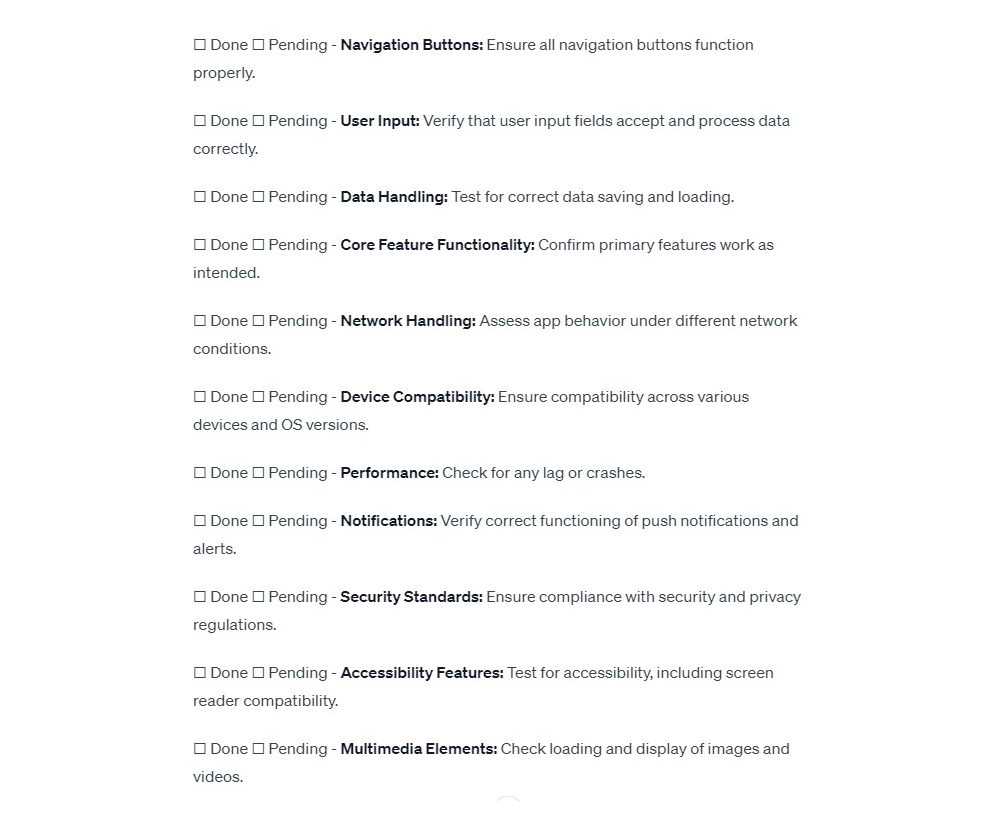
When to use the software testing checklist?
Software testing checklists are also helpful in manual testing scenarios, where they can guide testers through various aspects of the software. Key areas where checklists prove invaluable include:
- Smoke testing: This involves a rapid assessment to confirm the critical functions of the software work as intended.
- Regression testing: These tests ensure that new updates or changes haven't adversely impacted the existing functionalities.
- Exploratory testing: Testers actively engage with the software, exploring its features to uncover any defects.
How to use software testing checklists during different testing stages
Now, let's move on to the practical examples. Below, you will see how you can use testing checklists depending on where you are in your software testing process.
1. Pre-testing preparation
The initial phase in software testing, pre-testing preparation, sets the stage for a successful and efficient testing process.
1. Understanding what to test - Identifying test requirements
The process begins by determining the exact aspects of the software that need testing. This step requires a thorough examination of the software's specifications and requirements.
The aim is to understand the functionalities and features that need verification, ensuring that the software aligns with its intended purpose.
2. Ensuring the right conditions - Setting up a testing environment
Establishing a suitable testing environment is the next critical step. This environment should replicate real-world operating conditions as closely as possible to yield reliable test results. It involves configuring necessary hardware, software, network settings, and other essential tools. A well-set-up environment helps minimize unforeseen variables, allowing for the consistent reproduction of any issues.
Pro tip
Global App Testing (GAT) emphasizes replicating real-world environments to ensure comprehensive software testing. We focus on advanced targeting for a diverse and inclusive user representation, testing across various devices, connectivity environments, and global locations.
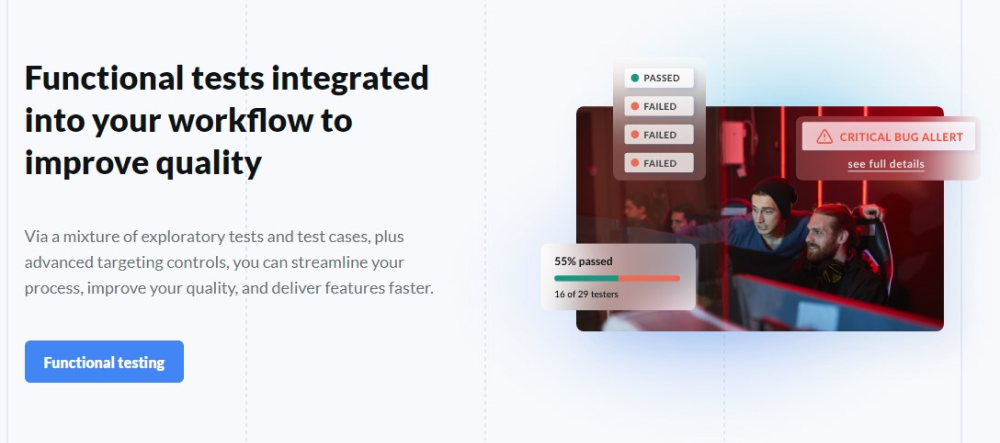
GAT also conducts functional bug reports, usability and UX assessments, and test case pass/fail evaluations, providing detailed insights for software improvements. Additionally, our approach integrates security and compliance checks to ensure software safety and adherence to regulations.
3. Outlining the testing strategy - Creating a test plan
A comprehensive test plan should contain the testing objectives, methods employed, test scope, necessary resources (including personnel and tools), and the timeline.
A well-structured test plan ensures a clear understanding of everyone's roles, responsibilities, and expectations. It promotes effective progress tracking and assessing how well the testing is performing.
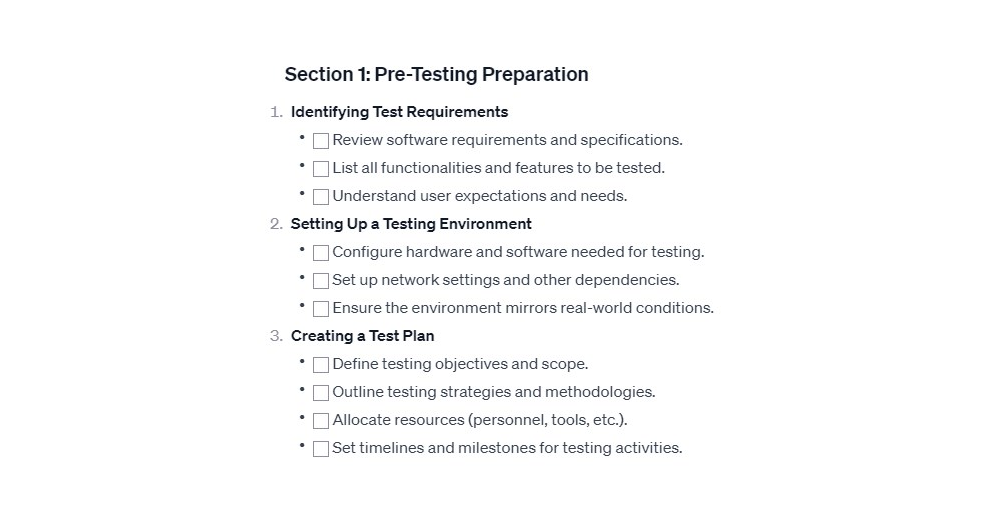
2. Types of tests to include in your checklist
Each type serves a unique purpose, and combined, they provide an overall software assessment.
1. Unit testing - Examining the smallest parts
Unit testing is the foundation of the testing process. It focuses on individual components or units of code to ensure that each part functions as intended. It's like checking each brick used to build a house. By testing these smallest elements of the software, you can catch and fix errors early, simplifying later testing stages. This type of test is usually automated and performed by developers.
2. Integration testing - Connecting the dots
Once individual units are tested, it's time for integration testing. This test checks how different modules or services work together. It's akin to ensuring that all the bricks you've tested individually fit together to form a wall. Integration testing identifies issues in the interaction between integrated units, which are crucial for seamless software operation.
3. System testing - Assessing the entire structure
System testing involves evaluating the complete, integrated software to verify that it meets specified requirements. It's like examining the entire building once all the bricks are in place. This test checks for overall functionality, reliability, and compliance with requirements. It's a critical step as it validates the software in its entirety.
4 . User acceptance testing (UAT) - Getting end-user approval
The final stage is UAT, where the end-users or stakeholders test the software in the real world. It's like having someone live in the building to ensure it's comfortable and meets their needs. UAT is crucial as it gauges how the software will perform in its intended environment and whether it meets user expectations.
Incorporating these tests into your checklist ensures that each critical aspect of the software is evaluated, from the smallest unit to the whole user experience, paving the way for successful software deployment.
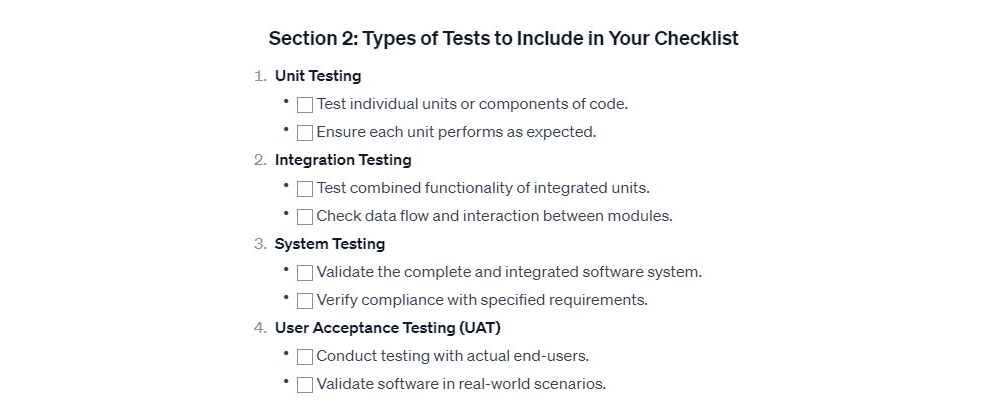
3. Test case development and management
The third section of your software testing checklist is about developing and managing test cases.
1. Designing effective test cases - Crafting a blueprint for testing
Creating test cases is like drawing up a detailed blueprint for your testing process. Effective test cases are thorough and clearly defined, leaving no ambiguity about what is being tested and the expected outcomes. The criteria for creating these test cases include:
- Specificity: Each test case should target a specific scenario or functionality.
- Repeatability: Test cases should be designed to deliver consistent results each time.
- Realistic conditions: They should reflect real-world scenarios to ensure the software's functionality in practical situations.
- Clear expected outcomes: Defining the expected results for each test case helps quickly determine if the test passes or fails.
2. Managing test cases - Keeping your testing organized
After developing test cases, it is crucial to manage them effectively. This includes:
- Categorizing them based on functionality, modules, or user stories can help in better management and execution.
- Using test management tools to track which tests have been executed, their outcomes, and any bugs or issues identified.
- As the software evolves, so should the test cases. Regularly reviewing and updating test cases ensures they remain relevant and cover new features or changes in the software.
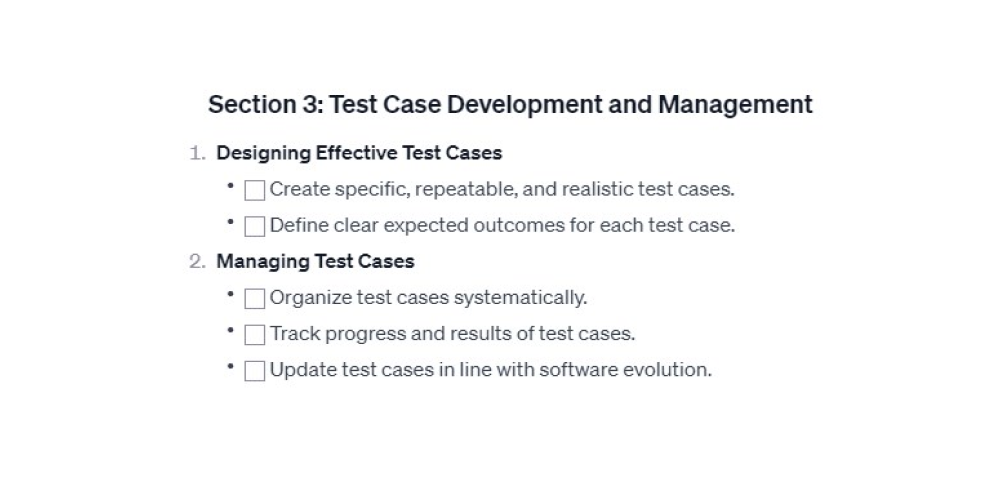
4. Execution and Reporting
This section focuses on the actual execution of tests and how the results are reported.
1. Running the tests - Implementing the test plan
The execution phase is where your test cases are put into action. Key strategies for efficient and effective testing include:
- Not all tests are of equal importance. Prioritize them based on criticality, user impact, and likelihood of failure.
- Automating repetitive or straightforward test cases can save time and reduce human error, allowing testers to focus on more complex areas.
- If resources allow, conducting tests in parallel will speed up the process without compromising testing quality.
- Ensure that the testing environment remains consistent throughout the process to avoid variability in results.
2. Logging defects - Recording issues accurately
Finding defects is a core goal of testing. Accurate defect logging involves:
- Each defect should be described clearly and succinctly, making it easy for developers to understand.
- Include the following information – steps to reproduce the defect, the testing environment, and any screenshots or logs.
- Assigning severity and priority helps manage and address defects efficiently.
3. Reporting - Sharing the findings
Communicating the results of testing is as important as the testing itself. Effective reporting involves:
- Regular updates during the testing phase keep everyone informed about the progress and any immediate concerns.
- A detailed report should be provided at the end of the testing cycle. This report should summarize the testing activities, results, defects found, and any recommendations.
- The report should not just list defects but provide insights to guide future development and improvement.
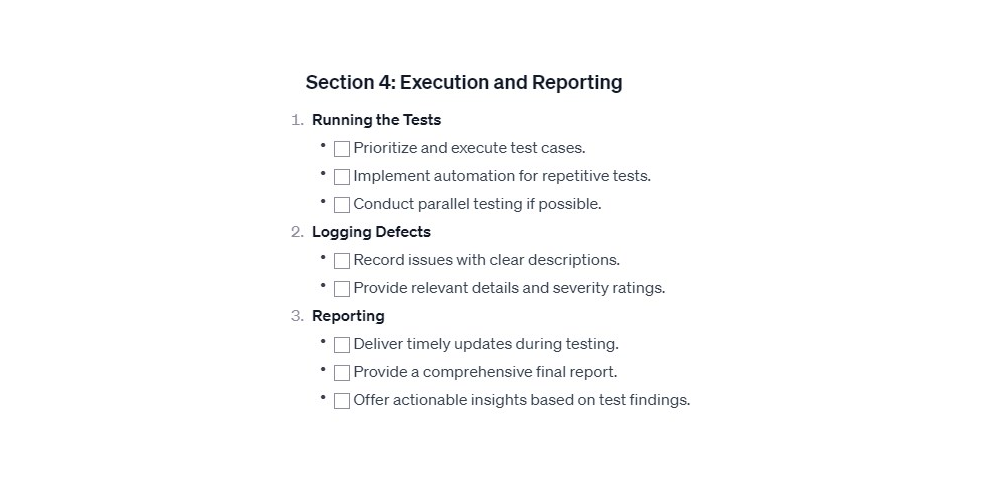
5. Post-testing activities
Certain activities are crucial after the main testing cycle to wrap up the process effectively and prepare for future development cycles.
1. Regression testing - Safeguarding against new bugs
Regression testing is a crucial activity in the post-testing phase. Its primary goal is to ensure that recent changes or additions to the software haven't adversely affected the existing functionalities. Even small changes can sometimes have unexpected repercussions, so by regularly running regression tests, you can ensure continuous quality.
2. Test Closure - Wrapping up the process
Finalizing the testing phase, known as test closure, involves several important steps:
- Verifying that all test cases have been executed and that all identified defects have been either resolved or documented for future resolution.
- Analyzing the testing process for any gaps or issues and documenting lessons learned.
- Officially closing the testing phase may include getting sign-offs from stakeholders and ensuring that all objectives set out in the test plan have been met.
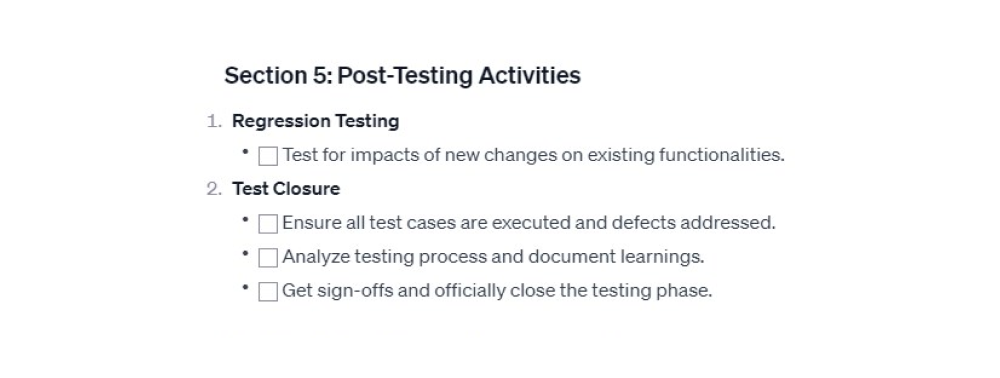
6. Continuous improvement
The final section emphasizes the importance of learning from the current testing cycle to enhance future testing efforts.
1. Learning from testing - Gaining insights for improvement
Every testing cycle presents an opportunity to learn and improve. This involves analyzing both the successes and shortcomings of the current testing process. Key questions to consider are: what worked well, what didn't work well, and why. Understanding these aspects helps in refining testing strategies and approaches.
2. Updating the checklist - Keeping it current and relevant
Update the software testing checklist regularly based on insights gained from each cycle. Add new tests, modify existing procedures, or remove obsolete steps. Conduct post-testing and continuous improvement activities to maintain software quality and lay a stronger foundation for future testing. This leads to better quality and more efficient testing processes over time.
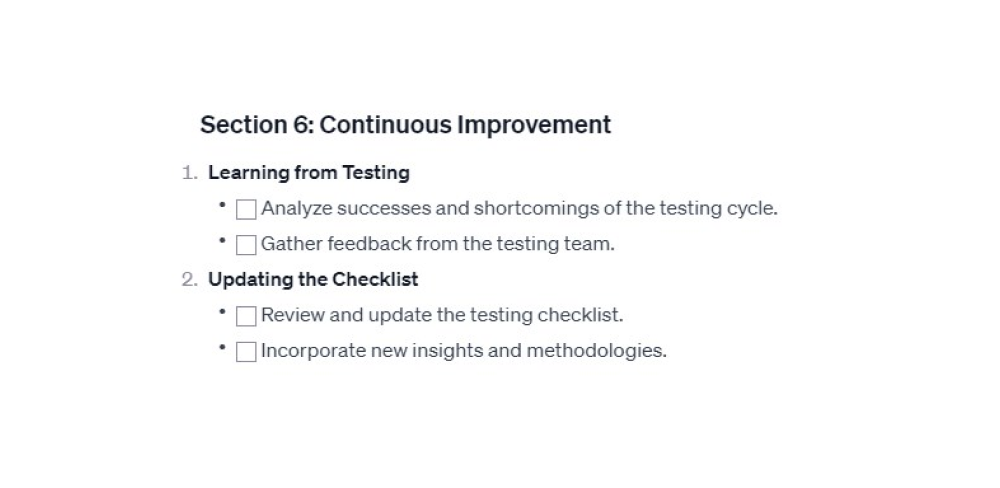
How can Global App Testing help you deliver high-quality software?
While checklists in QA software testing offer a structured and efficient approach to ensuring thorough software testing, the complexity and scope of modern software development often require more advanced solutions. This is where Global App Testing steps in. GAT offers a range of testing services that can significantly enhance the quality and speed of software releases.
We provide extensive web and mobile application coverage by leveraging a professional crowd of over 90,000 testers. This service is much faster than traditional manual QA and offers more flexibility than automation alone. For businesses looking to expand globally, Global App Testing offers localized functional testing and UX insights, helping to ensure that software products resonate well in different markets. Our service includes compatibility testing across various devices and operating systems, ensuring that your software delivers a consistent and reliable user experience, regardless of how or where it is accessed.
Make Global App Testing your partner in software development to ensure top-quality and functionality, perfectly aligned with your business needs. Tap into our expertise and resources today for a superior software product. Connect with Global App Testing now!
Join our community of 70,000+ testers around the globe and earn money testing websites and apps in your free time.
FAQ
What is a software testing checklist?
A software testing checklist ensures that all important testing aspects are covered.
Why is a software testing checklist Important?
It helps systematically cover all necessary tests and ensures no critical aspect is missed.
What should a testing checklist include?
It typically includes functionality, performance, user interface, compatibility, security, and more.
How often should the checklist be updated?
You should regularly update your software testing checklist to align with new features, technologies, and testing methodologies.
Can a software testing checklist improve QA efficiency?
Yes, it streamlines the process, making it more efficient and thorough.
Keep learning
5 Agile testing tools to improve your development in 2025
How Flip cut their regression test duration by 1.5 weeks
The 9 most common software testing mistakes you should avoid

